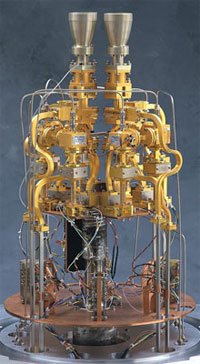Central Development Laboratory (CDL)
Central Development Laboratory (CDL)

 Technical innovations developed or enhanced for radio astronomy have contributed to improvements in communications antennas, transistors, cryogenic coolers, medical and scientific imaging, time and frequency standards, atomic clocks, and GPS navigation, 911 emergency call location, and precision spacecraft navigation. NRAO technology increases our understanding of the Universe and contributes to American competitiveness.
Technical innovations developed or enhanced for radio astronomy have contributed to improvements in communications antennas, transistors, cryogenic coolers, medical and scientific imaging, time and frequency standards, atomic clocks, and GPS navigation, 911 emergency call location, and precision spacecraft navigation. NRAO technology increases our understanding of the Universe and contributes to American competitiveness.
Radio telescope receivers almost universally use electronics known as HFET (heterostructure field-effect transistor) amplifiers. The NTC has pioneered HFET development and is largely responsible for their high performance. NTC amplifiers, e.g., were crucial to the success of the Wilkinson Microwave Anisotropy Probe (WMAP) satellite that accurately measured the Big Bang's remnant signal.
Digital auto- and cross-correlators are the heart of digital data processing for radio telescopes, and the NTC is a world leader in their development and construction. NTC personnel are now building the ALMA correlator, the world's fastest supercomputer, capable of 17,000,000,000,000,000 calculations per second!
Superconductor-Insulator-Superconductor (SIS) tunneling junctions are the foundations of many sensitive radio astronomy receivers. Working with the Microelectronics Fabrication Laboratory at the University of Virginia, the NTC has developed a reliable junction fabrication process that can be used in many different superconducting electronic circuits. NTC research has led to SIS mixer designs that are broadband, require no mechanical tuning, and achieve record performance.




Connect with NRAO